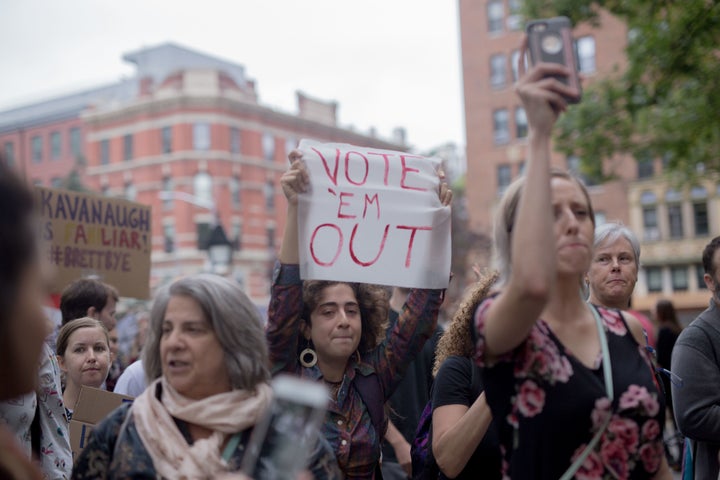
Midterm elections for the House are usually major defeats for the party of a newly elected president, and that bodes poorly for President Donald Trump and the Republicans, right? Well, sort of. There are lots of crosscurrents that could swamp this basic rule of American politics.
For starters, Trump is no ordinary Republican president. He is unpopular in the country as a whole, but wildly popular among his base. And more than most presidents, Trump is trying to turn the midterms into a referendum on himself.
Normally, that would be a dubious idea for a president whose popularity has never broken 50 percent. But given the dynamics, it’s probably a smart idea for the Republicans this year, since it could spike the crucial variable of Republican turnout.
Turnout in midterms invariably falls relative to presidential elections. But it doesn’t fall uniformly. Other things being equal, Republicans tend to vote in midterms in higher percentages than Democrats.
That’s why the recent Democratic losses in a new president’s first midterm elections have been absolute blowouts — they lost 63 House seats in 2010 under Obama, and 52 House seats in 1994 under Clinton. But in 2006, the sixth year of an increasingly unpopular Bush presidency, the GOP lost a relatively mild 30 seats. In 2002, in Bush’s first midterm, thanks to his use of the Sept. 11 attacks to rally the flag, Republicans actually gained eight seats.
Here is one statistic that should chill Democrats. In the 2014 midterms, according to political scientist Andrew Hacker, just under 36 million Democrats turned out to vote in the House elections. That was a drop of more than 33 million from the 2012 presidential election, when Barack Obama was re-elected.
By contrast, over 40 million Republicans showed up to vote for House seats, a decline of just 22 million from the presidential year of 2016. That was 11 million fewer stay-at-home Republican voters than their Democratic counterparts.
If Democratic and Republican falloff in 2014 from 2012 had been roughly the same, Democrats would have gained House seats. In fact, they lost 13 seats.
Why do Democrats tend to stay home in greater numbers for midterm elections than Republicans? One reason is that presidential years, especially when the candidate is a galvanizing figure like Obama, tend to attract voters from demographic groups who are more loosely attached to the electorate, such as young, black and Latino voters. Those voters tend to drop off in midterms.
So, the 64-million-dollar question for 2018 is whose core voters will turn out in greater numbers ― the hard-core Trump voters, or liberal voters ― especially women, minorities and young people ― appalled by everything Trump stands for, most recently the Republican party-line vote to confirm Brett Kavanaugh for the Supreme Court and the shocking mistreatment of Christine Blasey Ford.
Depending almost on the day of the week, there appears to be good news or bad news for both sides. Since the Kavanaugh confirmation, Trump has been appearing at rallies, doubling down on his bombastic tactics, and his approval rating has improved slightly.

On the other hand, this may not translate into an advantage on Election Day. The authoritative and usually accurate site FiveThirtyEight now gives the Democrats an 85 percent chance of taking back the House, up significantly since the Kavanaugh confirmation.
And Nate Cohn in The New York Times reports good news for Democrats on the turnout front. Democrats and groups that support them appear poised to turn out at record levels for a midterm. Yet Cohn also reports that Republicans have a 6-point advantage with voters who turned out in the 2014 midterm, while Democrats have a 10-point advantage among voters who did not turn out last time. So, turnout of each party’s base will evidently be the whole ballgame.
Well, not quite the whole game. Another factor is swing voters. While party-line voting has become more prevalent in the past two decades, independent voters repelled by Trump are likely to vote Democratic for Congress this time, as Republican incumbents have a hard time distancing themselves from the president. Many Republican-leaning and independent women, who didn’t like Hillary Clinton in 2016 — but she is not on the 2018 ballot ― also may favor Democrats.
The other imponderables are voter suppression and the effect of Russian trolls and social media misinformation campaigns. An indictment recently unsealed in the ongoing investigation by special counsel Robert Mueller reveals that meddling by Russian intelligence is just as active in 2018 as it was in 2016.
So, the most recent news on midterm turnout should be more comforting to Democrats than some headlines about a Trump surge may suggest — but not too comforting. It’s going to be a nail-biter right up until election night.
Robert Kuttner is co-editor of The American Prospect and a professor at Brandeis University’s Heller School. His new book is Can Democracy Survive Global Capitalism? Follow him on Twitter at @rkuttnerwrites.
